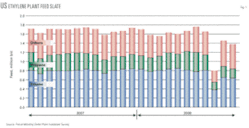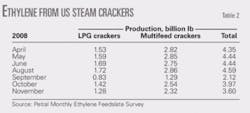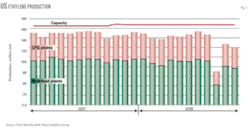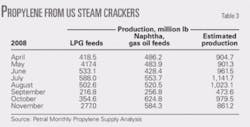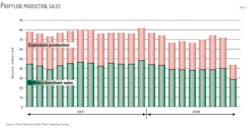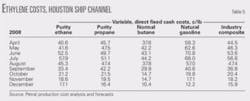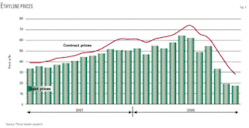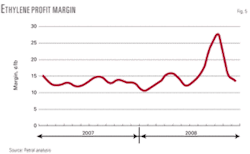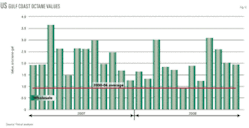The combination of two hurricanes in the Gulf of Mexico and a decline in global economic activity caused demand and production of olefins in the US to fall sharply in fourth-quarter 2008.
Unlike the quiet hurricane season of 2007, the 2008 Gulf of Mexico hurricane season was active and two storms made landfall in Louisiana and the upper Texas coast. Hurricanes Gustav and Ike caused widespread downtime for the olefins industry during September and October 2008.
Furthermore, the dual financial storms of panic and credit crunch reached their full fury during second-half 2008. As economic activity declined globally, demand for petrochemicals fell sharply during fourth-quarter 2008 and had a more pronounced effect on olefins production and profitability than Hurricanes Gustav and Ike combined.
Olefins producers experienced the most dramatic decline ever in feedstock costs as crude oil prices fell from an all-time high of $147/bbl in July to a low of $31/bbl in late December.
Olefin plant feed slates
Ethylene industry demand for fresh feed averaged 1.64 million b/d in second-quarter 2008. Hurricane-related downtime in September sharply curtailed industry operations.
Demand for fresh feed fell sharply in third-quarter 2008 and averaged 1.40 million b/d. Demand averaged 1.71 million b/d in July and August but only 800,000 b/d in September.
Demand for LPG feedstocks averaged 1.26 million b/d in second-quarter 2008 but declined to 1.05 million b/d in third-quarter 2008 (Table 1). Despite the decline in LPG demand, the feed slate remained much lighter than during 2007.
LPG feeds accounted for 77% of total fresh feed in second-quarter 2008 vs. 74% of fresh feed in second-quarter 2007. LPG demand accounted for 75% of fresh feed in third-quarter 2008 vs. 72% in third-quarter 2007. Economics for ethane were favorable during second and third quarters 2008 and ethane’s share averaged 51% of fresh feed in second-quarter 2008 but slipped to 47% in the third quarter.
Ethylene producers responded to the credit crunch and decline in demand for petrochemicals by sharply curtailing production rates beginning in October. Based on projected ethylene industry operating rates of 70-72% for fourth-quarter 2008, total demand for fresh feedstocks will average 1.35-1.40 million b/d. Total demand for LPG feedstocks will average 900,000-950,000 b/d during fourth-quarter 2008.
Fig. 1 shows historic trends for ethylene feed slates.
Ethylene production
Ethylene production from fresh feed totaled 13.2 billion lb in second-quarter 2008 but declined to 11.5 billion lb in third-quarter 2008. Ethylene production from steam crackers during second-quarter 2008 was 260 million lb more than in first-quarter 2008 (almost 3 days’ output).
Production in third-quarter 2008 was 1.73 billion lb less than in second-quarter 2008 (about 19 days of production). Loss of production in September 2008 due to Hurricanes Gustav and Ike accounted for virtually all the quarterly decline in ethylene production during third-quarter 2008. Production losses due to Gustav and Ike were about 0.5 billion lb more than losses following Hurricanes Katrina and Rita in 2005.
Production from LPG plants totaled 4.81 billion lb in second-quarter 2008 and 4.36 billion lb in third-quarter 2008 (Table 2). Production in second-quarter 2008 was 43 million lb less than in first-quarter 2008 (less than 1 day of production). Production in third-quarter 2008 was 455 million lb less than in second-quarter 2008 (about 9 days of production).
Operating rates for LPG crackers averaged 89% of nameplate capacity (based on capacity of 21.6 billion lb/year) during second-quarter 2008 but only 79% during third-quarter 2008. Multifeed crackers operated at 85% of nameplate capacity (based on capacity of 39.2 billion lb/year) during second-quarter 2008 and at 71% during third-quarter 2008.
Operating rates for the industry overall averaged 86.0% during second-quarter 2008 but slipped to 74% during third-quarter 2008.
Fig. 2 shows trends in ethylene production.
US propylene production
Although industry operating rates during second-quarter 2008 were higher than in first-quarter 2008, propylene from steam crackers totaled only 2.77 billion lb in second-quarter 2008, or 168 million lb less than in first-quarter 2008 (about 5 days of production).
Furthermore, coproduct propylene production during second-quarter 2008 was almost 400 million lb less than year-earlier volumes (almost 13 days of production). Coproduct propylene supply during second-quarter 2008 was significantly less than year-earlier volumes due to record high demand for ethane and weak demand for heavy feeds.
Consistent with the decline in operating rates due to the hurricanes, coproduct supply declined again in third-quarter 2008 and totaled only 2.64 billion lb, or 124 million lb less than during second-quarter 2008 (about 4 days of production).
Propylene production from LPG feeds totaled 1.37 billion lb in second-quarter 2008 and was 332 million lb more than production in first-quarter 2008. Propylene from LPG feeds, however, was 138 million lb less than year-earlier volumes. Propylene production from LPG feeds declined slightly in third-quarter 2008 and totaled 1.31 billion lb or 62 million lb less than in second-quarter 2008.
Propylene production from naphthas, condensates, and gas oils totaled 1.40 billion lb in second-quarter 2008 and was 412 million lb less than during first-quarter 2008. Coproduct yields of propylene from heavy feeds declined to 1.33 billion lb during third-quarter 2008, or 68 million lb less than in second-quarter 2008.
Ethylene producers maximized their use of ethane during second-quarter 2008; but ethane demand declined 22% in the third quarter, while demand for all other feeds declined only 6%. On a relative share basis, heavy feeds accounted for 53% of fresh feed in third-quarter 2008 vs. 49% in second-quarter 2008.
Table 3 shows trends in coproduct propylene production from LPG and multifeed plants.
Refinery propylene supply
Refinery propylene sales into the merchant market are a function of fluid catalytic cracking unit feed rates, FCCU operating severity, and economic incentives to sell propylene rather than use it as alkylate feed.
Normally, FCCU feed rates and operating severity reach their seasonal peaks during the second and third quarters. According to US Energy Information Administration’s statistics, however, US Gulf Coast FCCU feeds in second-quarter 2008 were 2.4% less than in 2007 and 14% lower in third-quarter 2008 (Table 4).
Refinery-grade propylene production during second-quarter 2008 averaged only 38.4 million lb/day and was 272 million lb less than in first-quarter 2008 (about 6.5 days of production). Production was 366 million lb less than in second-quarter 2007 (about 9 days of production).
Refinery propylene sales declined to 35.4 million lb in third-quarter 2008. Refineries in Louisiana and Texas experienced substantial downtime during September due to Gustav and Ike. As a result, total refinery propylene sales in third-quarter 2008 were 540 million lb less than year-earlier volumes (about 12 days of production).
Total domestic propylene supply was 6.23 billion lb in second-quarter 2008, which was 751 million lb lower than in second-quarter 2007. Domestic production declined in third-quarter 2008 and totaled only 5.87 billion lb, or 1.04 billion lb less than year-earlier volumes.
Fig. 3 shows trends in coproduct and refinery merchant propylene sales.
Ethylene economics, prices
Feedstock prices, coproduct values, and ethylene plant yields determine ethylene production costs. We maintain direct contact with the olefin industry and track historic trends in spot prices for ethylene and propylene. We use a variety of sources to track trends in feedstock prices.
Some ethylene plants have the necessary process units to convert all coproducts into high-purity streams. Some ethylene plants, however, do not have the capability to upgrade mixed or crude streams of various coproducts and sell some or all their coproducts at discounted prices. We evaluate ethylene production costs in this article based on all coproducts valued at spot prices.
Ethylene production costs
Production costs for ethylene in the Houston Ship Channel (based on full spot prices for all coproducts) increased 15-30% during second-quarter 2008. Production costs for ethane increased to 52-53¢/lb in June vs. 40-41¢/lb in April.
Production costs for propane increased to 49-50¢/lb in June vs. 45-46¢/lb in April. Production costs for natural gasoline increased to 70-71¢/lb in June vs. 58-59¢/lb in April. Production costs for ethane and propane were 13-15¢/lb higher than in second-quarter 2007, but production costs for natural gasoline were 30¢/lb more than in 2007.
Production costs increased to an all-time record high of 50-60¢/lb in July 2008 but fell sharply during August and September. Production costs based on purity ethane declined 36% during third-quarter 2008 and averaged 33-34¢/lb in September vs. 57-58¢/lb in July.
Production costs for propane declined 15% and averaged 41-42¢/lb in September vs. 51¢/lb in July. Production costs for natural gasoline declined nearly 43% and averaged 40-41¢/lb in September vs. 70-71¢/lb in July.
Average production costs for natural gasoline during second-quarter 2008 were 19¢/lb more than ethane and 16¢/lb higher than for propane. Although production costs for all feedstocks declined during the third quarter, natural gasoline’s premium narrowed to 9-10¢/lb vs. ethane and 8-9¢/lb vs. propane (average for the third quarter).
Declines in ethylene production costs accelerated during fourth-quarter 2008. Production costs across the board were 18-22¢/lb in October and 17-20¢/lb in November.
The quarterly decline for production costs based on ethane and propane were 55-60%, and 70% for natural gasoline. Production costs in December were about 15-17¢/lb for ethane and propane and 10-12¢/lb for natural gasoline.
Although strong economic support for ethane ended during the fourth quarter, ethane’s share of fresh feed in LPG crackers increased and its share of fresh feed in multifeed crackers remained steady. Production costs based on natural gasoline and light naphthas of similar quality were unusually weak during the fourth quarter due to abnormally weak prices for unleaded regular gasoline during late September through late December.
Table 5 shows trends in ethylene production costs.
Ethylene prices, profit margins
Contract prices for ethylene averaged 66.5¢/lb in second-quarter 2008, which was 6¢/lb more than in first-quarter 2008. During second-quarter 2008, contract prices increased to 70.5¢/lb in June vs. 63.5¢/lb in April.
Contract prices averaged 67.8¢/lb for third-quarter 2008 or only 1.3¢/lb more than the average for the second quarter. Contract prices for ethylene reached an all-time high of 74.5¢/lb in July but declined in August and September. Contract prices for September settled at 62.75¢/lb.
The collapse in feedstock prices and spot prices for ethylene precipitated a belated collapse in contract prices during the fourth quarter. Contracts settled at 28.25¢/lb in December vs. 50.75¢/lb in October. For the full quarter, contract prices averaged 38.9¢/lb, or 28.9¢/lb less than the third-quarter average.
Margins based on contract ethylene prices and LPG feedstocks were stronger in the second quarter. Margins based on purity ethane production costs averaged 13.5¢/lb, or 5.7¢/lb more than in first-quarter 2008. Margins based on propane averaged 10.8¢/lb and were 5.1¢/lb. Production based on natural gasoline and light naphthas, however, generated losses of 5-6¢/lb vs. losses of 1-2¢/lb in first-quarter 2008.
Financial turmoil, the credit crunch, and a deepening recession took a heavy toll on petrochemical demand. As demand declined, profit margins for LPG feedstocks began to erode, but margins based on natural gasoline and light naphthas recovered.
Margins based on purity ethane costs fell 3.5¢/lb and averaged 9.9¢/lb. Margins based on purity propane costs declined 2.3¢/lb and averaged 8.5¢/lb. Margins based on natural gasoline, however, increased 5.8¢/lb and averaged 0.2¢/lb.
Margins for all feedstocks were weak during the fourth quarter—especially during November and December. Margins based on purity ethane and purity propane costs fell to breakeven levels in November and December. Margins based on natural gasoline, however, averaged 3-4¢/lb during November and December vs. 13-15¢/lb during September and October.
Historically, during second-quarter 2007, spot prices for ethylene fluctuated within a tight range of 50-52¢/lb and averaged 51.2¢/lb, or 5.2¢/lb more than in the third quarter and 12.3¢/lb more than in second-quarter 2007. The higher spot ethylene prices during fourth-quarter 2007, however, did not keep pace with rising variable production costs.
Instead, margins based on spot prices and variable production costs narrowed to 8-13¢/lb during the fourth quarter for purity ethane. Margins based on natural gasoline and similar light naphthas collapsed to 3¢/lb in December from 12¢/lb in October.
Spot prices for ethylene averaged 58.4¢/lb in second-quarter 2008 and 55.4¢/lb in third-quarter 2008. When the economic recession deepened and feedstock prices fell sharply, spot prices for ethylene fell sharply during the fourth quarter. Spot prices averaged 33-34¢/lb in October but were in the 16-20¢/lb range in November and December and averaged only 22.5¢/lb for fourth-quarter 2008, or 32.1¢/lb less than the third-quarter average.
Figs. 4 and 5 show historic trends in ethylene prices (spot and net transaction prices) and profit margins based on composite production costs.
Octane values, propylene prices
We determine octane’s incremental value using the differential between unleaded premium and unleaded regular (ULR) gasoline prices divided by the difference in octane (87 octane for ULR gasoline and 93 octane for unleaded premium gasoline).
Octane values are a primary economic influence on spot prices for refinery-grade propylene and toluene. Trends in spot prices for these two products tend to influence prices for other coproducts.
Octane values weakened during second-quarter 2008 and averaged 1.48¢/octane-gal but rebounded and averaged 2.07¢/octane-gal during third-quarter 2008 and 2.06¢/octane-gal in fourth-quarter 2008.
Fig. 6 shows historic trends in incremental octane values on the US Gulf Coast.
Refinery, polymer-grade C3=
Prices for all grades of propylene move in tandem with each other, and differentials between grades are generally constant within a narrow range. The premium for polymer-grade propylene covers operating costs and profit margins for the various merchant propane-propylene splitters in Texas and Louisiana.
Spot prices for refinery-grade propylene averaged 67.7¢/lb during second-quarter 2008 and were 13.6¢/lb more than the average for first-quarter 2008. The premium for refinery-grade propylene prices vs. unleaded regular gasoline prices was 18¢/lb in the second quarter vs. 14.7¢/lb in the first quarter.
Spot prices for refinery-grade propylene reached an all-time high of 76.4¢/lb in July but began to decline in August. Prices averaged 64.3¢/lb in the third quarter and fell to only 22.5¢/lb in the fourth quarter. The price premium for refinery-grade propylene vs. unleaded regular gasoline averaged 14.3¢/lb in the third quarter but only 1.8¢/lb in the fourth quarter.
Contract prices for polymer-grade propylene increased during the second and third quarters but declined in the fourth. Contract prices averaged 69.8¢/lb in the second quarter and 78.3¢/lb in the third quarter. Although contract prices for polymer-grade propylene bucked the tide of falling prices in the third quarter, a general decline in demand for petrochemicals took effect and prices fell to 36.7¢/lb in the fourth quarter.
Winter, spring 2009 outlook
The market’s obsession with tight supply being the main factor in crude prices ended abruptly in July 2008. Almost overnight, the focus shifted to the combined bearish influences of financial crises, the credit crunch, and emerging global economic recession. Concerns with these problems dominated price trends for crude oil and feedstocks during second-half 2008.
Based on monthly averages, spot prices for West Texas Intermediate (WTI) declined almost 71% during second-half 2008. In response to the price collapse, producers around the world delayed or cancelled major projects for oil production and refining capacity expansions.
OPEC responded to the collapse in crude prices with a series of agreements to reduce their production and tighten the global crude supply-demand balance. In view of OPEC’s poor historic record of compliance with its production quota agreements, WTI prices could easily range from a low of $25/bbl to a high of $50-60/bbl during first-half 2009.
We expect weakness in demand for gasoline and diesel fuel, however, to remain foremost among the concerns affecting crude prices during first-half 2009. Forecasts for ethylene production costs and prices are based on WTI prices of $40-45/bbl during first-half 2009.
Ethylene production costs (full cash costs) will be about 16-20¢/lb. Spot ethylene prices will average 22-25¢/lb. Profit margins will average 5-8¢/lb for purity ethane and 7-10¢/lb for purity propane.
The author
Daniel L. Lippe ([email protected]) is president of Petral Worldwide Inc., Houston. He founded Petral Consulting Co. in 1988 and cofounded Petral Worldwide in 1993. He has expertise in economic analysis of a broad spectrum of petroleum products including crude oil and refined products, natural gas, natural gas liquids, other ethylene feedstocks, and primary petrochemicals. Lippe began his professional career in 1974 with Diamond Shamrock Chemical Co., moved into professional consulting in 1979, and has served petroleum, midstream, and petrochemical industry clients since that time. He holds a BS (1974) in chemical engineering from Texas A&M University and an MBA (1981) from Houston Baptist University. He is an active member of the Gas Processors Association, serving on the NGL Market Information Committee and currently serving as vice-chairman of the committee.


